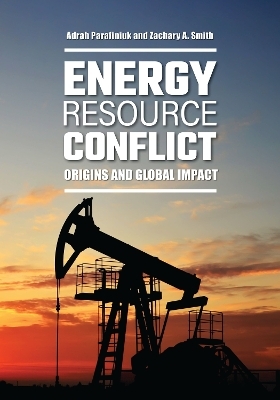
Energy Resource Conflict
Bloomsbury Academic (Verlag)
978-1-4408-7180-1 (ISBN)
- Noch nicht erschienen (ca. Februar 2025)
- Versandkostenfrei
- Auch auf Rechnung
- Artikel merken
This book examines international and sometimes intranational conflicts over energy resources, including ancient empires, 20th-century wars over oil, and the explosive growth of renewable energy. The volume begins with a series of chapters tracing the evolution and future implications of energy production and clashes over these vital resources. Next, readers will discover a collection of essays addressing fascinating yet sometimes contentious facets of the subject, including the current limits of renewable energy sources and the role nuclear power should play. A collection of 50 encyclopedic entries round out the book, providing readers with concise explanations of key concepts and terms.
Energy resource conflicts have shaped the world we live in. After humans settled across the planet, growing empires began to compete for resources. First, they competed for wood, then steel and coal. The ability to mine these resources and turn them into trains, ships, and weapons decided which countries would dominate the world. Oil became the most important international resource by the turn of the 20th century and has remained so until the present day. But, as the authors argue, humans have the technology to transition from fossil fuels to renewable energy for the vast majority of their energy needs, despite corporate fossil fuel interests. Using advanced statistics on the use and growth of all major energy sources, this book is an excellent source of information on the predicted growth of various forms of energy as well as the inevitable—yet not necessarily peaceful—transition toward renewable and carbon-free energy sources.
Adrah N. Parafiniuk teaches at Northern Arizona University, USA. He is the author of 108 Steps to Fix the Planet: A Guide to a Healthier, Happier, and More Joyous Life (2013). He has published work on energy and green gilding as well as on motivations for sustainable behaviors and pro-environmental behaviors. Zachary A. Smith was Regents' Professor at Northern Arizona University, USA. Smith was widely published, including such works as The Environmental Policy Paradox, 8th Edition (2022), Globalization (2008) (with Justin Ervin) and Protecting Our Environment: Lessons from the European Union (2005) (with Janet R. Hunter).
Introduction
Part I
Chapter 1: Origins and Causes
Overview
The History of Energy Types
Location, Location, Location: Origins of the Oil Industry
Chapter 2: Current Impact and Linkages
Overview
Modern War
Current Geopolitical Conflict
Local Conflict
Conclusion
Chapter 3: Responses
Introduction
International Responses
Technological Responses
Carbon Storage
Intensive and Expensive Geoengineering
Economic Changes
Industry Responses to Climate Change
National Responses
Conclusion
Chapter 4: Future Implications
Introduction
Consequences of Little to No Change in Energy Resource Use
Future Energy Projections Based on Current Trends
Possible Major Transitions
Transitioning Countries
Chapter 5: Contributed Essays
Introduction
The Dangers of Corporate Power Concerning Climate Change by Vivian Ike
The Power of Business Corporations to Drive Energy Transformation: The RE100 Case by Haley N. Anderson
The Dirty Future of Coal by Laine Munir
Limits of Solar and Wind by Helena Solman
The Promise of Nuclear Energy by Ayesha Sadiqa
Part II: A–Z Entries
Introduction
Agricultural Revolution
Biofuels
Biomass Energy
Carbon Capture and Storage (CSS)
Carbon Footprint
Carbon Offsets
Carbon Tax/Carbon Market/Carbon Credits/Cap and Trade
Cascade Effect
Climate Engineering or Geoengineering
Coal
Common Pool Resources
Concentrated Solar Power (CSP)
CO2
Crude Oil
Deepwater Drilling
Enhanced Recovery/Hydraulic Fracking/Horizontal Drilling
Forest Management
Fuel Cells
Fusion
Geothermal Energy
Greenhouse Effect and Greenhouse Gases (GHGs)
Green Revolution
Human Dispersal
Hydrocarbons and Hydrocarbon Gas Liquids
Hydroelectric Power
Hydrogen Economy
Megafauna
Milankovitch Cycles
Mineral Rights
Molten Salt Reactor (MSR)
Natural Gas
Net Zero
Nuclear Fission, Nuclear Fuel, and Nuclear Power Plants
Ocean Currents
Peat Megafires and Coal Seam Fires
Petroleum
Photovoltaics
Proven Reserves
Renewable Energy
Steam Power (Steam Engines)
Sustainability
Tar Sands/Oil Sands
Tidal Energy
Waste-to-energy (WTE)
Wave Energy
Wind Power
Zero Emissions Energy
About the Authors and Contributors
Index
| Erscheint lt. Verlag | 20.2.2025 |
|---|---|
| Verlagsort | London |
| Sprache | englisch |
| Maße | 178 x 254 mm |
| Themenwelt | Geschichte ► Teilgebiete der Geschichte ► Militärgeschichte |
| Geschichte ► Teilgebiete der Geschichte ► Wirtschaftsgeschichte | |
| Naturwissenschaften ► Biologie ► Ökologie / Naturschutz | |
| Sozialwissenschaften ► Politik / Verwaltung ► Europäische / Internationale Politik | |
| Sozialwissenschaften ► Politik / Verwaltung ► Staat / Verwaltung | |
| ISBN-10 | 1-4408-7180-9 / 1440871809 |
| ISBN-13 | 978-1-4408-7180-1 / 9781440871801 |
| Zustand | Neuware |
| Informationen gemäß Produktsicherheitsverordnung (GPSR) | |
| Haben Sie eine Frage zum Produkt? |
aus dem Bereich


